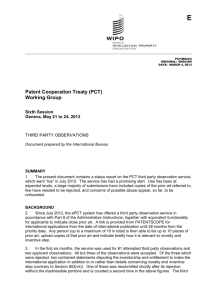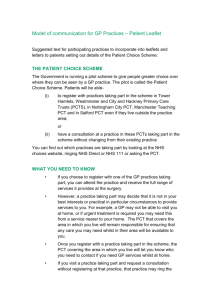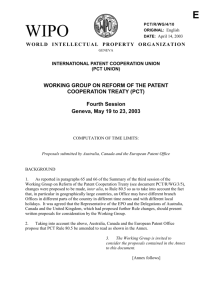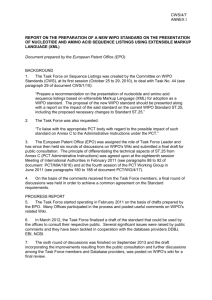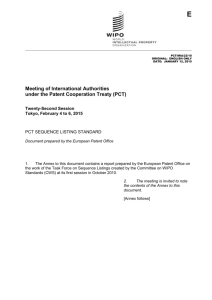PCT/R/WG/8/8: Emergency Preparedness Measures
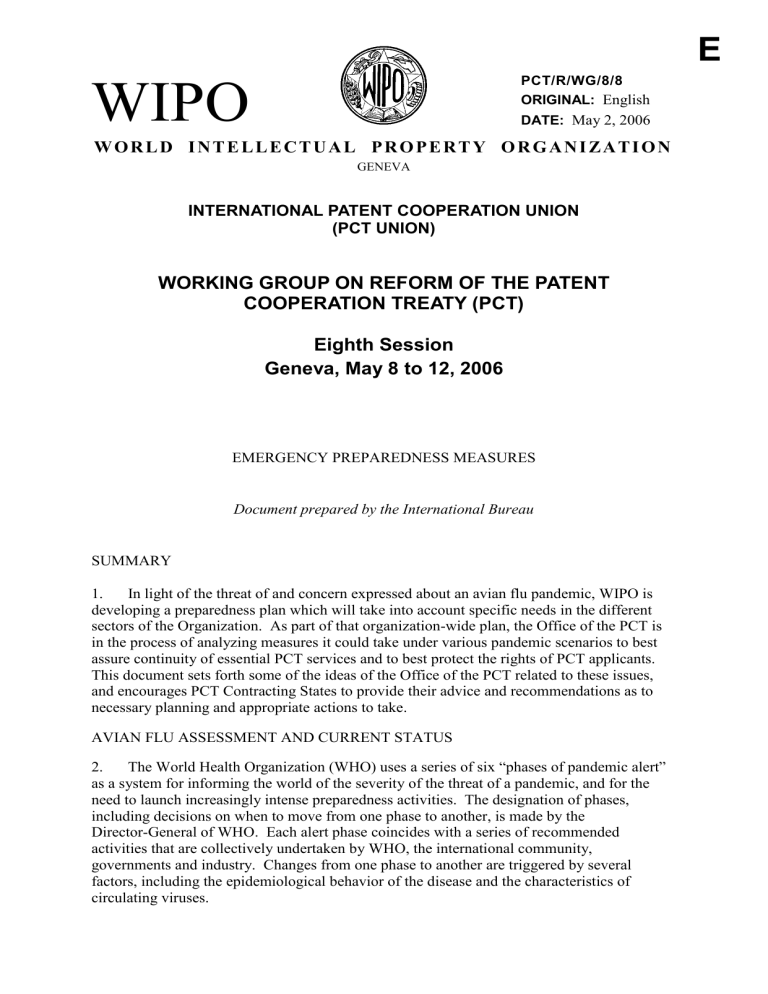
WIPO PCT/R/WG/8/8
ORIGINAL: English
DATE: May 2, 2006
W O R L D I N T E L L E C T U A L P R O P E R T Y O R G A N I Z A T I O N
GENEVA
E
INTERNATIONAL PATENT COOPERATION UNION
(PCT UNION)
WORKING GROUP ON REFORM OF THE PATENT
COOPERATION TREATY (PCT)
Eighth Session
Geneva, May 8 to 12, 2006
EMERGENCY PREPAREDNESS MEASURES
Document prepared by the International Bureau
SUMMARY
1. In light of the threat of and concern expressed about an avian flu pandemic, WIPO is developing a preparedness plan which will take into account specific needs in the different sectors of the Organization. As part of that organization-wide plan, the Office of the PCT is in the process of analyzing measures it could take under various pandemic scenarios to best assure continuity of essential PCT services and to best protect the rights of PCT applicants.
This document sets forth some of the ideas of the Office of the PCT related to these issues, and encourages PCT Contracting States to provide their advice and recommendations as to necessary planning and appropriate actions to take.
AVIAN FLU ASSESSMENT AND CURRENT STATUS
2.
The World Health Organization (WHO) uses a series of six “phases of pandemic alert” as a system for informing the world of the severity of the threat of a pandemic, and for the need to launch increasingly intense preparedness activities. The designation of phases, including decisions on when to move from one phase to another, is made by the
Director-General of WHO. Each alert phase coincides with a series of recommended activities that are collectively undertaken by WHO, the international community, governments and industry. Changes from one phase to another are triggered by several factors, including the epidemiological behavior of the disease and the characteristics of circulating viruses.
PCT/R/WG/8/8 page 2
“
Interpandemic period
“Phase 1
. No new influenza virus subtypes have been detected in humans. An influenza virus subtype that has caused human infection may be present in animals. If present in animals, risk of human infection or disease is considered to be low.
“Phase 2
. No new influenza virus subtypes have been detected in humans.
However, a circulating animal influenza virus subtype poses a substantial risk of human disease.
“Pandemic alert period
“Phase 3 . Human infection(s) with a new subtype, but no human-to-human spread, or at most rare instances of spread to a close contact.
“Phase 4 . Small cluster(s) with limited human-to-human transmission but spread is highly localized, suggesting that the virus is not well adapted to humans.
“Phase 5
. Larger cluster(s) but human-to-human spread still localized, suggesting that the virus is becoming increasingly better adapted to humans, but may not yet be fully transmissible (substantial pandemic risk).
“Pandemic period
“Phase 6
. Pandemic: increased and sustained transmission in general population.” 1
3. According to the WHO Director General, the world is presently at Phase 3 of the
Pandemic Alert Period : a new influenza virus subtype is causing disease in humans but is not spreading efficiently and sustainably at the human level
2
.
4. The WHO has also set out the following situation assessment concerning the avian influenza pandemic threat:
“1. The risk of a pandemic is great.
“Since late 2003, the world has moved closer to a pandemic than at any time since
1968, when the last of the previous century’s three pandemics occurred. All prerequisites for the start of a pandemic have now been met save one: the establishment of efficient human-to-human transmission. During 2005, ominous changes have been observed in the epidemiology of the disease in animals. Human cases are continuing to occur, and the virus has expanded its geographical range to include new countries, thus increasing the size of the population at risk. Each new human case gives the virus an opportunity to evolve towards a fully transmissible pandemic strain.
1
2
WHO/CDS/CSR/GIP/2005.5; WHO global influenza preparedness plan: The role of WHO and recommendations for national measures before and during pandemics, pg. 2
( http://www.who.int/csr/resources/publications/influenza/WHO_CDS_CSR_GIP_2005_5.pdf
).
See http://www.who.int/csr/disease/avian_influenza/phase/en/index.html
PCT/R/WG/8/8 page 3
“2. The risk will persist.
“Evidence shows that the H5N1 virus is now endemic in parts of Asia, having established an ecological niche in poultry. The risk of further human cases will persist, as will opportunities for a pandemic virus to emerge. Outbreaks have recurred despite aggressive control measures, including the culling of more than 140 million poultry.
Wild migratory birds – historically the host reservoir of all influenza A viruses – are now dying in large numbers from highly pathogenic H5N1. Domestic ducks can excrete large quantities of highly pathogenic virus without showing signs of illness.
Their silent role in maintaining transmission further complicates control in poultry and makes human avoidance of risky behaviours more difficult.
“3. Evolution of the threat cannot be predicted.
“Given the constantly changing nature of influenza viruses, the timing and severity of the next pandemic cannot be predicted. The final step – improved transmissibility among humans – can take place via two principal mechanisms: a reassortment event, in which genetic material is exchanged between human and avian viruses during co-infection of a human or pig, and a more gradual process of adaptive mutation, whereby the capability of these viruses to bind to human cells would increase during subsequent infections of humans. Reassortment could result in a fully transmissible pandemic virus, announced by a sudden surge of cases with explosive spread. Adaptive mutation, expressed initially as small clusters of human cases with evidence of limited transmission, will probably give the world some time to take defensive action. Again, whether such a “grace period” will be granted is unknown.
“Responding to the avian influenza pandemic threat: recommended strategic actions
“4. The early warning system is weak.
“As the evolution of the threat cannot be predicted, a sensitive early warning system is needed to detect the first sign of changes in the behaviour of the virus. In risk-prone countries, disease information systems and health, veterinary, and laboratory capacities are weak. Most affected countries cannot adequately compensate farmers for culled poultry, thus discouraging the reporting of outbreaks in the rural areas where the vast majority of human cases have occurred. Veterinary extension services frequently fail to reach these areas. Rural poverty perpetuates high-risk behaviours, including the traditional home-slaughter and consumption of diseased birds. Detection of human cases is impeded by patchy surveillance in these areas. Diagnosis of human cases is impeded by weak laboratory support and the complexity and high costs of testing. Few affected countries have the staff and resources needed to thoroughly investigate human cases and, most importantly, to detect and investigate clusters of cases – an essential warning signal. In virtually all affected countries, antiviral drugs are in very short supply. The dilemma of preparing for a potentially catastrophic but unpredictable event is great for all countries, but most especially so for countries affected by H5N1 outbreaks in animals and humans. These countries, in which rural subsistence farming is a backbone of economic life, have experienced direct and enormous agricultural losses, presently estimated at more than US$ 10 billion. They are being asked to sustain
– if not intensify – resource-intensive activities needed to safeguard international public health while struggling to cope with many other competing health and infectious disease priorities.
PCT/R/WG/8/8 page 4
“5. Preventive intervention is possible, but untested.
“Should a pandemic virus begin to emerge through the more gradual process of adaptive mutation, early intervention with antiviral drugs, supported by other public health measures, could theoretically prevent the virus from further improving its transmissibility, thus either preventing a pandemic or delaying its international spread.
While this strategy has been proposed by many influenza experts, it remains untested; no effort has ever been made to alter the natural course of a pandemic at its source.
“6. Reduction of morbidity and mortality during a pandemic will be impeded by inadequate medical supplies.
“Vaccination and the use of antiviral drugs are two of the most important response measures for reducing morbidity and mortality during a pandemic. On present trends, neither of these interventions will be available in adequate quantities or equitably distributed at the start of a pandemic and for many months thereafter.”
3
INTERNATIONAL BUREAU EMERGENCY PREPAREDNESS MEASURES
5. The United Nations and the World Health Organization have expressed concern about the possibility of an avian flu pandemic. So as to have a plan in place that ensures the best possible protection for the staff and their dependants in all United Nations organizations, the
United Nations System Medical Directors have circulated contingency guidelines to all heads of offices, departments and field offices.
6.
To coordinate the United Nations’ response worldwide, the United Nations system has also created a coordination mechanism bringing together key programme managers from all relevant parts of the United Nations family. The Secretary-General has appointed a United
Nations System Senior Coordinator for Avian and Human Influenza, Dr. David Nabarro, seconded from the World Health Organization
4
.
7. Given that the prime responsibility for the security of the personnel and assets of all international organizations rests with the host country (Switzerland), Geneva-based UN agencies are coordinating with representatives of the host country and of the Geneva authorities to complete their respective preparedness plans.
3
4
WHO/CDS/CSR/GIP/2005.8; Responding to the avian influenza pandemic threat ( http://www. who.int/entity/csr/resources/publications/influenza/WHO_CDS_CSR_GIP_05_8-EN.pdf
)
More information can be found in Pandemic Planning and Preparedness Guidelines for the
United Nations System , 15 March 2006
( http://www.humanitarianinfo.org/westafrica/3_themes/3.5_birdflu/Pandemic%20Planning%20 and%20Preparedness%20Guidelines %20for% 20the%20UN%20System.pdf
) . The UN
Medical Services Staff Contingency Plan Guidelines for an Influenza Pandemic are contained in this document as Annex A.
PCT/R/WG/8/8 page 5
8. Consonant with United Nations and World Health Organization concerns, the Director
General has set up within WIPO an Avian Flu Management Team charged with developing a
WIPO Preparedness Plan for the eventuality of an avian flu pandemic, which would take into account the specific needs in the different sectors of the Organization, including Recovery
Plans, as well as the ways these specificities can be harmonized in a general approach to the emergency by the Organization.
9. The International Bureau has begun consideration of its response to an avian flu pandemic as it relates to the operation and functioning of the PCT system, making certain assumptions about the scenarios that it might face. Initial consideration has been given to a scenario corresponding to Phase 5 in which most staff members would be instructed to stay at home until the pandemic wave has passed, as outlined in the UN Medical Services Staff
Contingency Plan Guidelines. The following paragraphs set out the views of the Office of the
PCT as to PCT-related services which may be able to be maintained in light of such a
scenario. Paragraph 22, below, briefly treats a Phase 6 scenario.
Phase 5 Scenario
10. In the view of the Office of the PCT, the emergency measures proposed to be taken in order to preserve applicants’ rights in such a public health crisis would be:
(a) declaring that the International Bureau and receiving Office of the International
Bureau are officially closed for business, publishing that information and notifying PCT applicants and partner patent offices of that status, and receiving and storing any incoming
mail items accordingly, as further outlined in paragraphs 11 to 14, below;
(b) providing information services to PCT applicants and partner patent offices, via web-based information and telephone helpline functions, as further outlined in
(c)
maintaining the fax and e-filing systems, referred to in paragraph 17, below.
Declaring the International Bureau and receiving Office of the International Bureau officially closed for business
11. The UN system and the host country have not completed the preparedness plan at the time of preparing this document. It is also uncertain how rapid it would be for a shift to
Phase 5 to lead to such a disruption as a sudden and significant reduction in the number of staff members at work. However, on the basis of the UN documents, including the document entitled “Pandemic Planning and Preparedness Guidelines for the United Nations System”, issued on March 15 (an internal document shared among the UN agencies), it is prudent that, as soon as the entry into Phase 5 is confirmed by WHO, the International Bureau should consider and determine whether and when it should make the declaration of the closure for business.
PCT/R/WG/8/8 page 6
12. If the receiving Office of the International Bureau is officially closed for business, then there are protections for those PCT applicants, under Paris Convention Article 4(C)(3)
5
, who have claimed priority but who have not yet filed a PCT application with the receiving Office of the International Bureau. Likewise, if the International Bureau is officially closed for business, there are protections in place, under PCT Rule 80.5, for those PCT applicants whose document or fee submission-related PCT time limits would expire during the closure period.
Note, however, that such a declaration of official closure would not have any effect on applications which have already been received by any receiving Office (including the receiving Office of the International Bureau) and which are currently in the processing pipeline.
13. By the time the International Bureau declares the closure for business, it is most likely that, partly due to medical instructions and also as a result of measures adopted by the host country and the Geneva authority, only the minimum number of PCT Operations staff members would be present to work. It would be important to have those staff members group together any incoming mail and courier items by date, so that the date of receipt can be clearly derived later 6 , and to store any incoming items in a manner that will permit their processing in the quickest and most well-organized manner when staff are able to return to work in significant numbers. If sufficient manpower exists in the Operations area, continuation of scanning and indexing of incoming papers would also be helpful.
14. It would also seem sensible to urge other PCT Offices and Authorities which are affected by the pandemic to also declare themselves officially closed during this period, for the purposes of Rule 80.5 and national phase entry time limits.
Information Services
15. During the emergency period, it would be important to have the ability to remotely manage the content of the PCT web site in order to publish:
(a) updated information about the closure of the International Bureau and the receiving Office of the International Bureau, and availability of PCT services and recommendations to filers. The date on which the International Bureau plans to reopen for official business could also be announced via this means, in order to allow applicants to file their applications before that time;
(b) information about emergency measures being implemented;
(c) information about human contact numbers.
5 Article 4(C)(3) of the Paris Convention reads: “If the last day of the period is an official
6 holiday, or a day when the Office is not open for the filing of applications in the country where protection is claimed, the period shall be extended until the first following working day.”
In a severe crisis situation, it can be assumed that mail and courier deliveries will either stop completely or at least the deliveries to WIPO will not be a top priority for the PTT and the various private courier services.
PCT/R/WG/8/8 page 7
16. It would also be important to be able to remotely send email messages to PCT mailing list subscribers, and to remotely manage PCT telephone services such as the PCT Infoline, so as to allow PCT staff members to respond to queries from home, providing important information to filers and potential filers.
Maintaining the PCT fax machines and e-filing system
17. This would be done as a joint effort between the Office of the PCT, WIPO administrative services and the PCT Information Systems Division. It is important to note that while every effort would be made by the Office of the PCT to keep these filing and submission means available during such an emergency period, this will almost certainly not mean that applicants would be able to file new applications and make other submissions by these means and expect them to be processed as usual; during this period, processing of faxed and electronically-filed submissions will be subject to the same limitations as on paper submissions.
Views on essential PCT processing
18. While provisional protection can begin with international publication and the
International Bureau’s failure to publish in a timely fashion can potentially erode the applicants’ rights to be able to recover against infringers, it is not believed that international publication is truly an essential service given the backdrop of a global public health crisis. If it were deemed desirable and the International Bureau were able to continue some sort of adapted international publication service (in order to work on the pending applications and thus reduce the internal backlog), a simplified publication system (one which would not require contributions from or use of the current bibliographic data management and publication preparation systems) could be envisioned, including, for example, scanning of the request form and the record copy and simply posting those documents on a simple web page.
Further, in case of sufficient advance warning of an impending Phase 5 closure, the
International Bureau could potentially set up an emergency team and procedure to ensure that the international applications which are prepared for publication (and possibly the next several publication batches) could be published as usual, in order to take greatest advantage of work which has already been done.
What legal provisions are applicable?
19. Current PCT provisions that might be implicated and/or applicable in such a scenario are PCT Article 48 (“Delay in Meeting Certain Time Limits”); PCT Rule 82.1 (“Delay or
Loss in Mail) and PCT Rule 82.2 (“Interruption in the Mail Service”; PCT Rule 82 bis
(“Excuse by the Designated or Elected State of Delays in Meeting Certain Time Limits”); and PCT Rule 82 ter (“Rectification of Errors Made by the Receiving Office or by the
International Bureau”) (potentially applicable if the International Bureau were to make an error in according an international filing date in post-emergency processing).
PCT/R/WG/8/8 page 8
20. The PCT currently has no “suspend the rules” provision such as exists in the
Consolidated Patent Rules applied by the United States Patent and Trademark Office 7 .
Further legal provisions needed?
21. One question raised by this scenario and plan which is of relevance to the PCT
Contracting States is whether the States would like the International Bureau to possess special emergency powers beyond those provisions contained in the current PCT Regulations, in order to better deal with such cases, for example, giving more flexibility to extend deadlines, etc. and otherwise protect applicants from consequences of emergencies.
Phase 6 Scenario
22. In a Phase 6 scenario as envisioned by the WIPO Avian Flu Management Team, WIPO would be completely shut down—no one would be on the premises of WIPO, and no PCT staff would be in the Office. The main question for the Office of the PCT in relation to this scenario would be whether mail and courier services would be operating. If these services were still operating, then instructions would need to be provided to the security guards as to how to receive and store such deliveries in order to best preserve information such as the date of receipt. In the case where no mail and courier services were operating, then the emergency measures set out under the Phase 5 scenario, above, would continue to apply, such as remotely dealing with emails, accessing the network, managing information resources, coordinating the PCT Infoline, etc. Note that under a Phase 6 scenario, it would appear difficult to maintain the PCT fax machines and PCT e-filing system.
REPOSITORY FOR NATIONAL/REGIONAL OFFICE PREPAREDNESS MEASURES
23. Member States may wish to consider whether the International Bureau should facilitate access to information by national offices on their emergency preparedness measures (if any) by setting up an online repository for this kind of information on WIPO’s web site, similar to what it does in WIPO’s online Directory of Intellectual Property Offices
( http://www.wipo.int/directory/en/ ) and the Country Profiles from the WIPO Guide to
Intellectual Property Worldwide( http://www.wipo.int/about-ip/en/ipworldwide/ ).
24. The Members of the Working Group are invited to consider the contents of this document and possible other solutions to the issues raised in this document.
[End of document]
7 37 CFR 1.183 reads: “ Suspension of rules In an extraordinary situation, when justice requires, any requirement of the regulations in this part which is not a requirement of the statutes may be suspended or waived by the Director or the Director’s designee, sua sponte, or on petition of the interested party, subject to such other requirements as may be imposed. Any petition under this section must be accompanied by the petition fee set forth in § 1.17(f).”
